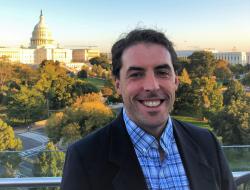It’s hard to get a foothold in the labor market when it is crumbling beneath your feet.
Young people just starting out in the working world are typically among the hardest-hit in a recession, and the current pandemic-fueled economic downturn is no exception. In the best of times, young people attempting to enter the labor force are often at a disadvantage by virtue of their smaller networks and relative lack of experience. Now, millions of young people are at the end of a much longer line of job seekers, greatly reducing their chances of finding employment.
COVID-19 relief packages provided critical economic aid to households in the form of enhanced unemployment benefits, paid leave, and direct financial support. But the economy is still short an astonishing 10 million jobs compared to February 2020. In the week ending February 13, 2021, more than 850,000 new people filed for unemployment insurance—four times more than the same week one year prior (215,000).
It’s time to focus on creating jobs for young people. Below, we outline a two-pronged approach: subsidized jobs and community-building service opportunities. These efforts would be initiated to address the immediate crisis, but they should still continue after the pandemic is under control. As automatic stabilizers, they could grow when the labor market is weak and contract as it recovers. Moreover, they address trends that predate the pandemic, including the increasing importance of bachelor’s degrees as a condition of employment security and the scarcity of career pathways for young people without such credentials.
A crisis for young people—especially young people of color
Between February and June 2020, the number of young people neither working nor going to school more than doubled, to over 10 million. While some of this increase is attributable to summer holidays, much of it is explained by COVID-19-driven job losses among 16- to 24-year-olds.
As of January 2021, young people are still on the edge. The unemployment rate for 16- to 19-year-olds stands at 14.8%, more than double the national rate of 6.3%. Faring somewhat better are 20- to 24-year-olds, but their unemployment rate is still more than 1.5 times the national rate.
Conditions are even more dire for young people of color. Not only are these young people—particularly young Black people—watching COVID-19 disproportionately ravage their families and communities, but they are also experiencing the pandemic’s greatest economic consequences. Unemployment rates have reached astronomical highs for Native American young adults, while young Black men have been slowest to recover from the April 2020 unemployment peak. These realities pile on to pre-existing racial disparities in unemployment and poverty rates that have dogged communities of color.
The dramatic impact of this economic crisis on young people is due, in part, to their concentration in industries that have seen steep job losses. Prior to the pandemic, one out of four young people worked in leisure and hospitality—the industry that experienced the highest number of job losses during the early months of the pandemic.
Young people were also hit hard during the Great Recession: Nearly one in five were unemployed in what was then a record high. Young adults who start their careers during such recessions face lasting economic consequences, and we are watching it happen again on a massive scale for the second time in less than 15 years.
Why the country needs a subsidized employment program for young people
As a first step to remedy this youth jobs crisis, we recommend a national hiring blitz facilitated by subsidized employment. In this model, the federal government pays for a portion of employee wages, making it easier for businesses to hire. Rather than backfilling firms’ balance sheets—as the Paycheck Protection Program does—subsidized jobs help workers reenter the workforce and allow companies to retool for the post-pandemic job market.
A big advantage of the subsidized employment approach is speed. The Great Recession showed that subsidized programs—such as the Temporary Assistance for Needy Families (TANF) Emergency Fund—can get money to employers and workers quickly
By paying for part of employee wages, these programs stimulate hiring to get the labor market moving again during economic downturns. They offer employers flexibility to rehire and recapture old business or strike out in new directions as sectors evolve. Employers can be in the public, private, or nonprofit sector, and include a broad range of industries, including IT, construction, food service, and more.
Creative subsidized jobs models could even offer workers access to subsidies to start their own businesses, or to groups of workers to start worker co-ops. And if they are complemented with supportive services, subsidized job programs can facilitate durable connections to the labor market for those who have been out of work for a long time, or for young people with little work experience.
The program would target job seekers and workers of all ages and education levels, but we anticipate that young adults would make up a sizable share of participants. Last year, members in both chambers of Congress introduced a bill along these lines—the Jobs for Economic Recovery Act—which could be incorporated into the next COVID-19 relief bill that Democrats are considering.
A national approach would send formula dollars to states, which would then decide which agency is best suited to oversee the program. In any case, we recommend close collaboration at the local level with workforce development boards, which have relationships with employers and regularly convene public and private sector actors. Heartland Alliance and researchers associated with Georgetown University, Columbia University, and the nonprofit MDRC have provided specific guidance on program design and implementation, and we recommend their work as useful resources.
Costs per slot will vary nationally, but we estimate a per-slot cost of $20,000 for 30 weeks of subsidized wages and supportive services. Creating opportunities for 2 million workers over the next 18 months would require a $40 billion investment, plus startup and program administration costs of at least 10%. Thus, we recommend a total of $44 billion in subsidized jobs funding.
Service jobs can rebuild communities and give meaning to young people
A complementary approach is to support community service initiatives that empower community leaders, local nonprofits, and young adults themselves to define what recovery means for them.
The pandemic has created urgent community needs related to education, social services, and emergency assistance. And other, longer-standing needs remain as well, including tackling climate change through renewable and resilient infrastructure installation, expanding access to child care as adults return to the workforce, and increasing digital literacy among older adults. A broad community rebuilding effort can create opportunities for young people to address these needs and improve where they live while finding meaning and gaining work experience.
To realize this rebuilding effort, we must quickly expand existing service programs that incorporate paid employment, such as YouthBuild, conservation corps, and AmeriCorps. These service programs focus on meeting community needs, and participants typically work through or are placed in nonprofit organizations. They usually include other elements such as ongoing education, mentoring, and professional development for participants, and may offer scholarships after completion.
Several federal agencies already fund or administer service initiatives. AmeriCorps is supported by the Corporation for National and Community Service, YouthBuild is supported by the Department of Labor, and conservation corps have agreements with agencies such as the National Park Service and U.S. Fish and Wildlife Service to maintain, protect, and improve natural and cultural resources. Moreover, there is a robust network of intermediaries, agencies, and organizations at the federal, state, and local levels with ample knowledge and capacity to expand and improve service initiatives.
We recommend increasing the living allowance for these service jobs (which is currently near the poverty level), as well as the size of the education award, which has lost value relative to rising tuition and now covers less than a year’s in-state tuition at a public university.
We estimate a cost of $23 billion over three years for this effort. This includes increasing the number of slots to 600,000 by 2024, increasing the living allowance to 175% of the poverty level, and increasing the scholarship to cover two years of in-state tuition at public universities and colleges, including technical colleges and apprenticeships.
In addition to established service programs, we should seed new community improvement efforts that empower young people to define what recovery means for their community. After a year of dislocation, disruption, and missed milestones, America’s youth need the chance to take the reins and direct their energy and ideas to projects they care about. This is how YouthBuild got its start: Young people in East Harlem, N.Y. wanted to make their community safer by renovating an abandoned building, and the now-defunct federal Law Enforcement Assistance Administration provided the necessary flexible funding to turn the idea into reality.
The federal government should recommit to such community improvement efforts by sending money to states, which can quickly disburse small grants to nonprofits with the capacity to engage young adults in community change. Grants averaging $500,000 over two years would provide a powerful spark for long-term community rebuilding. Including administration and technical assistance for grantees, we recommend investing $6 billion to seed 10,000 community-improvement projects.
The nation’s young people need our attention
One of the most basic tasks of any society is to launch the next generation and prepare them for success. We are failing.
Young adulthood is a time of seeking for meaning, purpose, identity, and direction. Young people need chances to develop agency and the ability to be productive and constructive in their own lives and the lives of others. They want to support themselves and their families through work. Let’s capitalize on these impulses.
The United States has accomplished such efforts before. We can do it again.
The Brookings Institution is committed to quality, independence, and impact.
We are supported by a diverse array of funders. In line with our values and policies, each Brookings publication represents the sole views of its author(s).









Commentary
America’s young people need jobs. The federal government should pay for them.
February 26, 2021